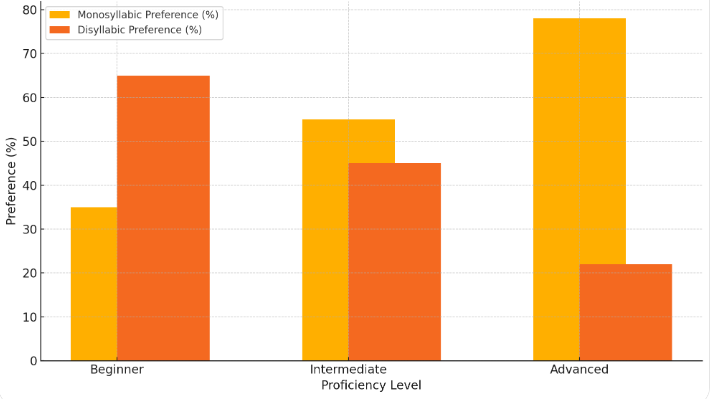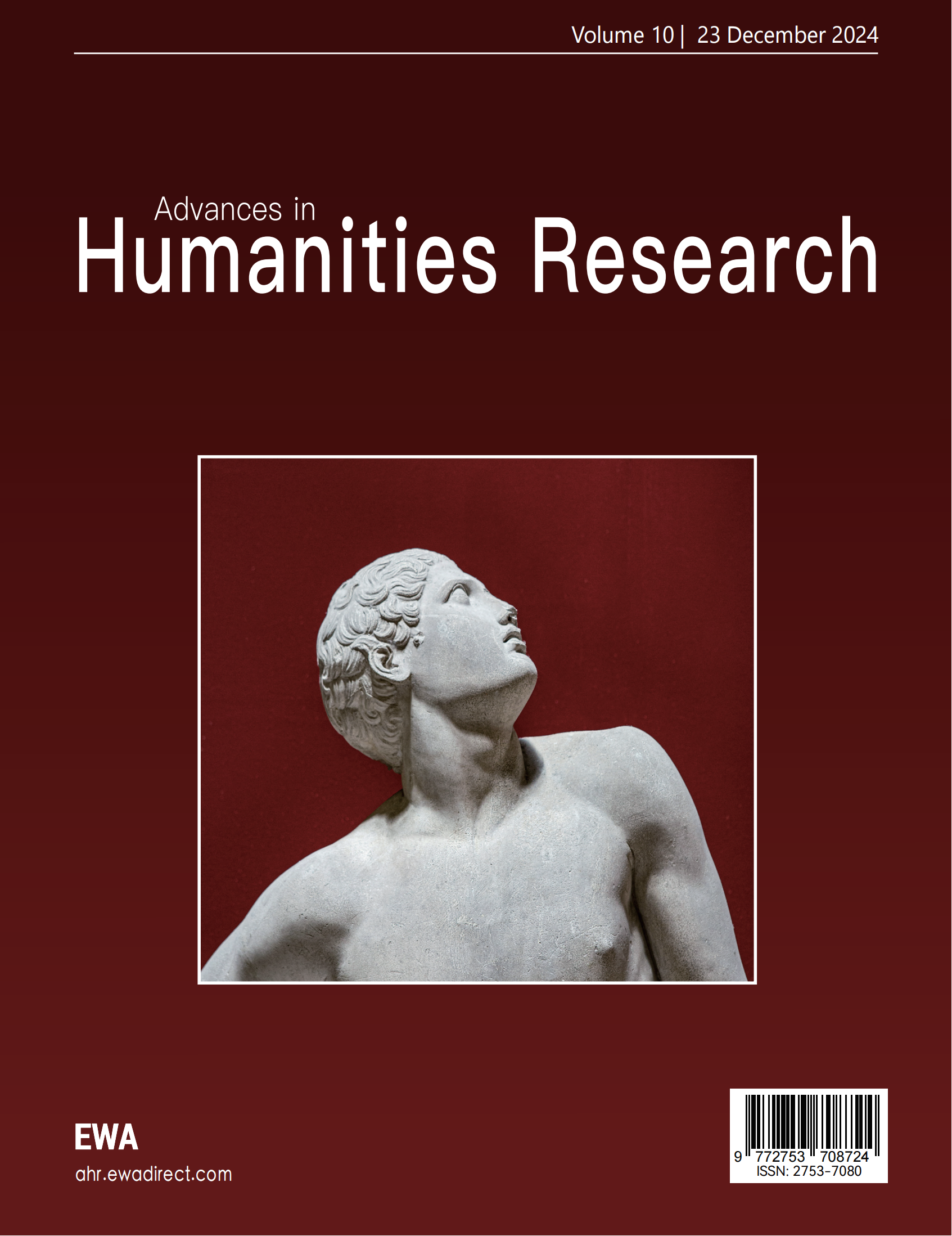1.Introduction
Syllable order is an important aspect of phonological learning for Chinese speakers, particularly those whose native languages belong to the Indo-European family. In contrast to Indo-European languages where words are often polysyllabic, Chinese tends to be monosyllabic or disyllabic, particularly when it comes to nouns. This variation in syllable complexity presents difficulties for learners in pronunciation, retention and cognition. Second-language research shows that syllable shape is a fundamental aspect of phonological learning, with syllable complexity influencing pronunciation and fluency as well as how comfortable a learner feels with unfamiliar words. While this is a valuable topic, there are relatively few studies that have investigated Chinese language learners’ preferences for syllable order, especially relative to proficiency [1]. We fill this hole by asking whether Indo-European Chinese language learners exhibit unique preferences for monosyllabic or disyllabic nouns, and whether these preferences vary with proficiency. In particular, it looks at learners’ use of same-morpheme nouns to isolate syllable shape as a defining variable and examine learners’ innate preferences independent of context or lexical context.
The study’s key research questions are: (1) Do learners display a preference for monosyllabic or disyllabic forms, and is that association related to fluency? (2) Are these preferences subject to cognitive or perceptual biases? Using a structured methodology using tasks such as the Noun Repetition Task and the Structure Selection Task, the paper hopes to provide feedback on how learners’ syllable preferences shift. These observations can assist language instruction by adapting syllable-specific training to proficiency, which in turn enables learners to adapt phonologically at various levels more easily.
2.Manuscript Preparation
2.1.Participants
The participants were chosen to be representative of a broad range of skills, which included beginner, intermediate, and advanced levels. This variation proved essential for spotting relationships between the learning stage and preference for syllable arrangement. Grouping by proficiency allowed for deeper understanding of possible patterns – each at a particular level – reducing group confounding variables [2]. The self-assessed skills were cross-checked against official records, official linguistic assessments and recent certificates to provide additional confidence in the information. This grading increased the statistician’s quality, offering a way to measure syllable preferences by proficiency.
2.2.Data Collection
Data were gathered in a multi-method fashion, starting with an in-depth survey. The questionnaire collected baseline data, such as each participant’s first Indo-European language and Chinese linguistic background. Answers to the survey revealed, at least in part, learners’ current attitudes toward monosyllabic and disyllabic noun forms, possibly capturing previously acquired biases and guiding experimental task design. This early stage enabled scientists to predict learners’ cognitive and perceptual biases toward certain syllable patterns. The experimental set-up consisted of two structured tasks: the Noun Repetition Task and the Structure Selection Task [3]. The Noun Repetition Task tested participants’ fluency and comfort with each syllable form, assessing hesitations or pronunciation errors when they recited monosyllabic or disyllabic versions. The Structure Selection Task was a forced-choice task that asked participants to declare a preference, reducing the number of neutral responses and allowing for quantitative analysis. They were carefully calibrated to exclude exogenous factors, like clear direction, so that outcomes matched natural rather than taught preferences [4].
2.3.Data Analysis
Data analysis involved both quantitative and qualitative approaches. Quantitative analysis focused on correlational and Chi-square tests to explore relationships between proficiency and syllable preference. The Chi- square test\( (χ^{2}) \)was instrumental in assessing whether the observed preferences were statistically significant. This allowed the researchers to distinguish actual preference trends from random variations. The Chi-square formula used in the analysis was:
\( χ^{2}=∑\frac{(O-E)^{2}}{E} \)(1)
where\( O \)represents the observed frequency of syllable choices, and\( E \)represents the expected frequency under a null hypothesis of no preference difference. Correlation coefficients\( (r) \)were also calculated to determine the strength and direction of the relationship between proficiency levels and syllable preference [5]. A positive\( r \)-value would indicate that as proficiency increases preference for one syllable type (e.g., monosyllabic) also increases. Qualitative data from open-ended survey responses underwent thematic coding, revealing underlying cognitive and perceptual biases, such as ease of pronunciation, familiarity, and perceived syllable complexity [6]. These insights enriched the quantitative findings by providing context for syllable preferences, suggesting that factors beyond proficiency alone—like cognitive processing or perceptual biases—might also influence learners preferences.
3.Experimental Procedure
3.1.Task Design
The tests were designed to enable the subjects to concentrate on their preferred syllable order without outside input. The Noun Repetition Task required users to repeat monosyllabic and disyllabic same-morpheme nouns. Randomising the number of nouns also prevented participants from identifying patterns or prejudices, and instead allowed preferences to come into play. The Structure Selection Task involved a forced-choice exercise in which participants were asked to select either monosyllabic or disyllabic pronunciations of a noun on a screen [7]. This architecture required respondents to select a clear winner, minimising the neutrals and allowing researchers to collect more precise data about preference patterns across proficiency levels.
3.2.Implementation Steps
Participants were allocated into proficiency groups (beginner, intermediate, advanced) and were taught standardized instructions to ensure continuity between sessions. In order to minimise the effects of noise and maintain fidelity in audio, the recordings were made in soundproof rooms using high-resolution recording equipment. Stacking was randomly assigned at each session to prevent sequence bias, ensuring that participants’ choices were a reflection of real preferences independent of task order. This environment was meant to allow people to react naturally and consistently. Figure 1 shows the workflow of implementation steps [8].
Figure 1. Implementation Workflow
3.3.Measures and Data Sources
The Structure Selection Task data were then averaged and sorted by the level of proficiency into monosyllabic or disyllabic preference. We analysed audio from the Noun Repetition Task for fluency, identifying any hesitations or mistakes to identify whether participants were familiar with each syllable format. Frequency measures served as a basis for quantification, enabling researchers to find patterns of syllable preference that could vary across skills [9]. Comparative data were collected and used for cross-sectional analysis, which allowed the examination of whether preferences for syllables could change as you got better at speaking the language.
4.Results
4.1.Overview of Findings
The findings showed contrasting patterns of preferences for syllable arrangement across levels of ability. Students who had just begun learned the language tended to choose disyllabic forms, perhaps because they knew polysyllabic word forms in their own Indo-European languages. This is in keeping with cognitive bias towards more comprehensible, identifiable patterns. Intermediate students, however, had an intermediate period, in which although disyllabic forms remained prevalent, more and more people started using monosyllabic forms. This change could be the result of intermediate learners being more familiar with Chinese grammar, and becoming increasingly fluent in monosyllabic patterns [10]. Higher-level learners had a strong preference for monosyllable structures, indicating more cognitive flexibility and likely phonological affinities with native speakers. Table 1 plots monosyllabic and disyllabic preference across all proficiency levels and demonstrates a clearly pronounced monosyllabic preference progression as proficiency increases.
Table 1. Frequency of Monosyllabic and Disyllabic Preferences by Proficiency Level
|
Proficiency Level |
Monosyllabic Preference (%) |
Disyllabic Preference (%) |
|
Beginner |
35 |
65 |
|
Intermediate |
55 |
45 |
|
Advanced |
78 |
22 |
4.2.Comparison by Proficiency Levels
Comparisons of syllable preferences across proficiency levels show that preference for structure changes significantly as the learner progresses. Students in first grade overwhelmingly preferred disyllabics, students in second grade were more evenly distributed, and students in third grade strongly preferred monosyllabics. This suggests a strong association between linguistic ability and monosyllabic preferences. The evidence suggests that more advanced students with more exposure and practice become intuitively aligned with the native Chinese syllable structures. This evolution shows that phonological learning can undergo structural adaptation: students develop a semi-native sensibility for monosyllabics over time, becoming more and more proficient in phonetic and phonological Chinese [11]. Figure 2 presents syllable preferences from proficiency to proficiency shows how monosyllabic preference becomes more prevalent with proficiency.

Figure 2. Syllable Structure Preference by Proficiency Level
4.3.Statistical Data Analysis
The statistical analysis confirmed the siqnificance of the observed trends Correlation analysis produced a positive correlation coefficient (r=0.62) between proficiency level and monosyllabic preference, indicating a moderate to strong positive relationship between increased proficiency and a preference for monosyllabic structures. Additionally, the Chi-square test yielded a significant result\( (χ^{2}=12.84,p \lt 0.01) \), reinforcing that these findings are statistically significant and not due to random variation. These statistical findings (as shown in\( Table 1 \)and Figure 2) offer robust quantitative evidence that advanced proficiency in Chinese correlates with a stronger preference for monosyllabic structures [12]. This supports the hypothesis that learners, as they progress, develop phonological preferences aligning more closely with native-like syllable structures, thus validating the study’s research questions on the impact of proficiency on syllable structure preferences.
5.Conclusion
These results highlight the importance of proficiency level in determining syllable structure preferences among Indo-European Chinese learners, and they show that monosyllabic preference emerges as students become more proficient. This evolution indicates that learners’ phonological structures change over time, shifting from disyllabic patterns we are used to in Indo-European languages to native-style monosyllabic patterns in Chinese. Basic students tended to favour disyllabics in particular, possibly due to the fact that polysyllabic structures are more commonly present in their native tongues. This bias correlates with cognitive processing inclinations, because first-time learners may initially prefer structures that appear less complex and less intellectually demanding because they have some linguistic prehistory.
As learners reach intermediate proficiency, a noticeable shift emerges, with a balanced preference for both monosyllabic and disyllabic forms. This transitional stage likely reflects the learners’ increasing exposure to Chinese phonological norms, as well as the growing capacity to process and reproduce monosyllabic structures with ease. This shift also implies that as learners advance, they become more attuned to the distinct phonological features of Chinese, facilitating a gradual adaptation away from structures typically seen in their native languages. High-level students tended to prefer monosyllabic, suggesting that proficiency is associated with greater phonological plasticity and conformity to speaker habit. The higher students’ preference for monosyllabic patterns may reflect the greater ability to internalise and re-create the fundamental syllabic patterns of Chinese phonology. The result is in keeping with second-language theory, where fluency is said to engender greater linguistic intuition and closer matching of native patterns. Moreover, the clear preference for monosyllabic sounds in advanced students may suggest that, given sufficient time and practice, learners’ phonological systems can undergo structural changes to follow patterns found in the target language. Statistical analyses supported these trends: correlation analysis showed a positive coefficient (r=0.62) between competence and monosyllabic preference, demonstrating a relatively robust relationship. The Chi-square test also confirmed the statistical significance of these results, showing that the preference for disyllabic over monosyllabic was not unintentional but directly related to proficiency. These findings support the study’s premise that ability determines syllable structure preferences, providing statistical evidence that, as learners improve, they prefer syllable structures more consistent with native speaker patterns.
These findings have important implications for phonological instruction in languages. Sprachtrainers can use these lessons to train the syllable structure according to the level of mastery. Beginners might benefit from disyllabic arrangements that are closer to their own local language patterns to make early acquisition easier. With time, teachers can gradually introduce monosyllabic forms to transition students into native-like phonological structures. This selective teaching might also help learners develop phonological adaptation, making learning Chinese syllable structures intuitive and effective. Future research could expand upon these findings by conducting longitudinal studies that track syllable preferences over time or by examining syllable preferences among learners from diverse linguistic backgrounds. Additionally, exploring the impact of specific teaching methods on syllable structure acquisition could provide further insights into optimizing phonological instruction for second-language learners. By deepening our understanding of how syllable structure preferences evolve with proficiency, this research contributes valuable knowledge to the field of second-language acquisition and offers practical strategies for enhancing the phonological skills of Chinese language learners.



